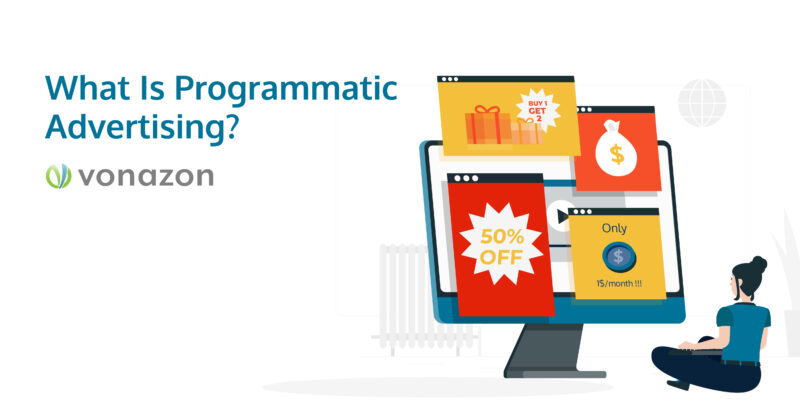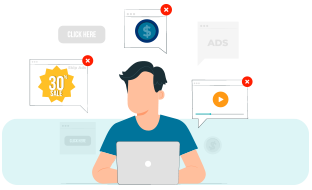
What is Programmatic Advertising?
Programmatic advertising services are a form of digital marketing that uses programmatic algorithms to purchase ad space in real time. Programmatic buying allows for more granular targeting than traditional advertising methods and can be used to reach specific audience segments with tailored messaging. These services can be used for brand awareness and direct response campaigns, and it is particularly well-suited for account-based marketing (ABM) initiatives. OTT programmatic advertising is a newer form of programmatic advertising solutions that specifically target consumers watching streaming content on platforms like Roku and Amazon Fire TV.
By using programmatic advertising solutions within campaign targeting, marketers can reach consumers engaged with long-form content and more likely to have an affinity for their brand. In this blog, you will learn the difference between “buyers” and “publishers” in online advertising and the multi-layered stages of programmatic advertising services that decide who, where, and when to unveil your advertisements during a campaign.
How and why is programmatic advertising successful?
Simply put, programmatic advertising services are successful because they’re efficient, precisely targeted, and uniquely scalable for your business.
These services raise the likelihood of advertisers reaching their target audience with the right messages at the correct time. This process saves advertisers time and resources by reducing the number of ads placed on irrelevant websites using real-time data reporting. What’s more, these reports automatically generate when programmatic advertising services record personal and behavioral data from several marketing platforms. Sellers then run these insights against different sales auction algorithms to instantly produce target audiences, online bids, and programmatic advertising channels to funnel relevant ads toward those leads. When this occurs, brand integrity strengthens due to advertisers’ ability to transparently swap out less effective campaign elements from ads and replace them with content that resonates with their audience.
What is Real-Time Bidding (RTB)?
Real-time bidding (RTB) is when companies buy and place ads online through automated auctions using precise programmatic advertising channels. RTB is considered a cost-effective way to purchase ad inventory with large audiences by enabling marketers to place thousands of ads without manually contacting online publishers one at a time. These programmatic advertising solutions are often facilitated by sellers using Supply-Side Platforms (SSPs), Ad Exchanges, and Demand-Side Platforms (DPSs) together to place relevant ads in front of their target audience. Through RTB, advertisers utilize frequency capping and bid forecasting tools to transform their marketing strategies, testing, controlling, evaluating, and predicting variables for optimized campaign targeting.
What is an Ad Exchange?
Ad exchanges connect companies wishing to buy advertisements and publishers who want to sell online ad space. They function as neutral digital marketplaces, using ad networks to arrange online inventory sales auctions between these two groups. Buyers who use ad exchanges bid on programmatic advertising channels ranging from display screen content, native videos, mobile ads, and in-app purchases. This online bidding process occurs through real-time ad exchanges connecting demand-side and supply-side platforms. Ad exchanges improve campaign efforts by blocking irrelevant websites or audiences, imposing limits on the number of times the same ads are shown to one user, and implementing budget pacing options.
Ad exchanges are typically divided into two categories: open exchanges and private marketplaces. Open exchanges are ad exchanges available to all sellers and buyers, especially ad networks and advertisers. Private marketplaces are invite-only ad exchanges where premium sellers and buyers compete for ad inventory by bidding on a private auction.

What is a Demand-Side Platform (DSP)?
A demand-side platform is an automated interface used in programmatic advertising services where marketers can purchase and manage ad inventories from many sources. Advertisers and publishers use DSPs to make buying and selling faster, cheaper, and more efficient. Real-time bidding allows these online placements to be sold within seconds during an auction. The main benefit of DSPs is that they lower your need to manage ad campaigns across multiple sites. Instead, you gain dashboard tools that connect you across consumers reports, publications, and targeting filters to find the right audience within one convenient location.
When running an ad campaign, there are four types of DSPs, mobile DSP, self-serve DSP, white label DSP, and managed DSP. Self-serve DSP gives advertisers complete control over ad-buying, selecting inventory, targeting, and campaign management. Mobile DSP supports mobile devices using tracking, OS, and user-friendly features to improve devices. White-label DSPs are advertising platforms without an associated brand, which buyers purchase and turn into their own product, cutting development costs. Managed DSP does all the work for an advertiser through an account manager overseeing the ad campaign.
Conclusion
The reality is that programmatic advertising services are gradually taking over the advertisement industry, especially the online sector of this market. 2023 has already seen a projected net growth of 91% digital ad spending on campaigns powered by programmatic advertising services. That means advertisers seeking to place ads and publishers with ad space have chosen which way the industry will shift.

Real-time bidding gives you the competitive advantage of saving time by bidding only on ad impressions and ad inventories relevant to your brand. It’s more cost-effective to let ad exchange determine your ad spending budget after identifying your target audience and programmatic advertising channels. You even have the power to increase the efficiency and reach of your ad campaigns using DSP programs. The old way of marketing simply leaves too many unpredictable elements that can now be improved with programmatic advertising solutions.
Account Executive
Vonazon Inc.

Vonazon can guide you through the process of creating fun and effective short form videos that are unique to your brand. We can also help you create campaigns around your videos that deliver results, grow your brand’s social media presence, and produce more leads.
Contact us today to begin your short form video journey.
Recent Posts
Categories
Categories
- ABM
- Account Management
- Analytics
- Artificial Intelligence
- Content Marketing
- Creative
- CRM
- Design
- eCommerce
- Email Marketing
- HubSpot
- HubSpot CRM
- HubSpot Marketing Hub
- HubSpot Partner
- Inbound Marketing
- Integrations and Migrations
- Lead Generation
- Lead Scoring
- Marketing
- Marketing Automation
- Marketing Strategy
- Native Advertising
- Omnichannel Marketing
- Organization
- PPC
- Programmatic Advertising
- Sales and Marketing Alignment
- SEO
- Social Media
- Staffing
- Trade Shows
- Videos
- Web Development
- Webinars
HOW CAN We
HELP YOU?
Lorem ipsum dolor sit amet, consectetur adipiscing elit.




